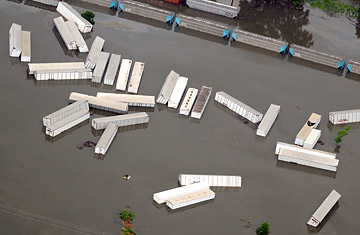
Flood waters surround train cars, top, and semi-trailers in Cedar Rapids, Iowa.
Here in Iowa, a swarm of locusts should be descending any minute now. After being plagued for the past three weeks by natural disasters of near-Biblical proportion, from wrath-of-God-style tornadoes to epic flooding, what next?
"I feel under siege with this weather," my friend Anne e-mailed this week, after reassuring me that her 15-year-old son was not among the Boy Scouts at an Iowa campground that was flattened by a tornado a few days ago. It was hard to react to that unfathomable tragedy — four teenagers killed, 48 people wounded — with the can-do stoicism that many Iowans have mustered in response to the sinking realization that yet another so-called "500-year flood" is slowly but surely swamping our state — just 15 years after the last one.
Coming so soon after the May 25 tornado in the northeastern Iowa town of Parkersburg that killed seven people and injured about 50, the June 11 tornado in western Iowa at the Boy Scout camp made me want to shake my fists at the heavens. But there's no time for fury. There's work to be done.
Right now, it's all about trying to prevent more flooding that is already devastating many communities, from Iowa's second largest city, Cedar Rapids (pop. 124,000), to one of its smallest, Chelsea (pop. 276). Later, it will be about dealing with the aftermath — the nasty consequences of flood water that Iowans remember all too well from the miserable clean-up of homes, businesses, and farms after the floods of 1993 and 1998.
Now that the fierce rain storms of recent days have stopped (temporarily we're told), for those of us who are relatively high-and-dry there's a strange disconnect between what we see out our windows and what we know is going on just a few miles away. As I type from my Des Moines home on the afternoon of Friday the 13th, I see my neighbor mowing the lawn, dogs barking, kids playing, normal life. It's sunny and dry. But I've just received an e-mail that in downtown Des Moines, about 10 minutes away, a voluntary evacuation is underway as water levels on the Des Moines River fast approach the top of the levee. Worried friends and family are starting to call and e-mail. And I've received a dire-sounding e-mail earlier in the day from the disaster volunteer center set up at the United Way office just north of downtown: "There is an URGENT need for volunteers to assist in the sand bagging effort. Volunteers are asked to report... throughout the day for deployment."
So I'll be "deploying" again soon — as I did on Thursday. Working alongside dozens of other Iowans — from the Des Moines area as well as from towns hours away — who felt compelled to do something, anything, my 16-year-old son and I spent several hours filling sand bags to try to support levees near a threatened north Des Moines neighborhood along the swiftly rising Des Moines River.
"I'm going to tell my wife I spent the day at the beach," joked a sweat-soaked, middle-aged guy, brushing off his overalls during a break from shoveling heavy sand into orange bags. A father and daughter, an inner-city church youth group, brawny twentysomething guys and spindly-legged teenage girls, they were all there — scooping and shoveling sand from large piles heaped onto a residential street next to a small city park.
During a break, we walked a short distance across the grassy park and down a trail through the trees to a clearing where we could spot the fruits of our labor — the start of what I was told will be a mile-long trail of sandbags piled two-feet high atop a leaky levee. In the distance, National Guard troops piled the bags. Below us, only a few feet away, was our new enemy — the river.
As they filled sandbags, some people shared updates, about conditions in various parts of Des Moines, Polk County and Iowa. For days, we Iowans have been comparing notes, sharing stories of water-soaked basements, flooded-out cars, water bursting out of manhole covers. We've been reminiscing, not fondly, about the flood of 1993 — when Des Moines lost its water supply for days (something we've been assured won't happen again, thanks to beefed-up flood prevention measures.)
We've been reading the paper and watching the tube, trying to keep up-to-date on the flood zones, evacuation orders, and road closures (including portions of Interstate 80); looking at wrenching images of flood scenes near and far: a woman crying on her Des Moines doorstep as she's told to evacuate; a couple row-boating through their mobile home park in Altoona; an Iowa City police officer wading through water with a little boy on his shoulders; an astonishing aerial view of downtown Cedar Rapids where downtown buildings look like rafts in an ocean. But mostly, my fellow sandbaggers work quietly, diligently, steadily, shoveling sand, filling bags, heaving them into piles and hoping for the best while preparing for the worst.
